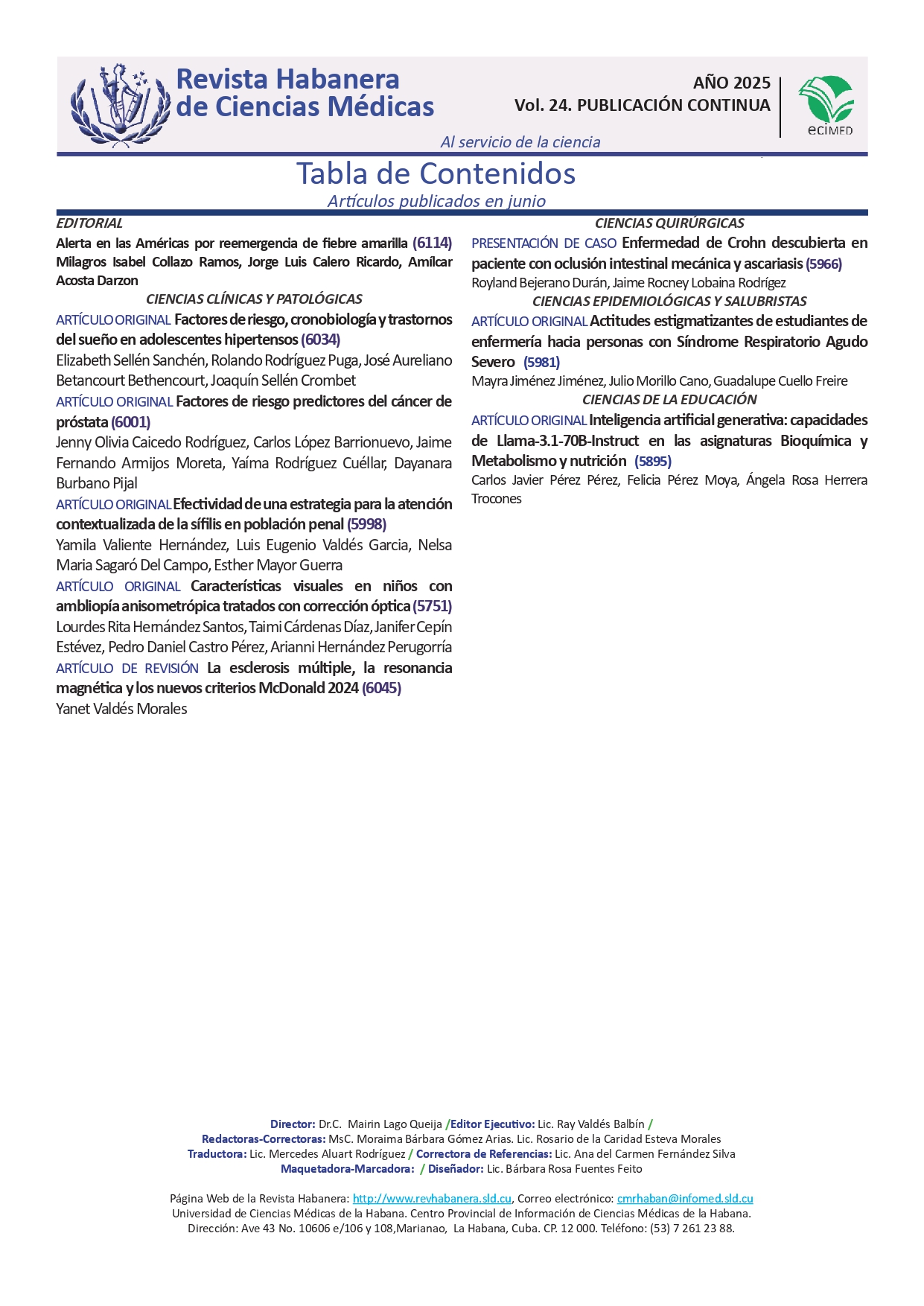Urban and rural differences in the relationship between altitude and central adiposity in the peruvian population
Keywords:
Body Mass Index, Waist-Hip Ratio, altitude, urban population, rural population, PeruAbstract
Introduction: The relationship between geographic altitude and central adiposity has been little explored, especially when considering differences between urban and rural areas in altitudinally diverse countries such as Peru.
Objective: To determine the variation in central adiposity among Peruvian adults based on geographical altitude and area of residence (urban or rural).
Material and Methods: Analytical cross-sectional study using secondary data from 20,489 adults from urban and rural areas. Variables included: residential altitude, waist-to-hip ratio, body mass index, height, and weight. Multiple linear regression, Student’s t-test, and decision trees using Chi-squared Automatic Interaction Detection were applied.
Results: In rural populations, the regression equation was: 6626.45 + (−2143.69 * waist-to-hip ratio) + (−1442.23 * height) + (−20.46 * weight). In urban populations, the equation was: 1071.439 + (719.152 * waist-to-hip ratio) + (586.837 * height) + (−20.328 * weight). The decision tree showed that living below 1 500 meters was mainly associated with a body mass index >30.296; between 1500 and 2 999 meters: body mass index between 22.957 and 24.692; at ≥3 000 meters: waist-to-hip ratio ≤0.470 with body mass index ≤22.957. In urban areas below 1 500 meters: waist-to-hip ratio ≤0.638 with body mass index between 30.599 and 32.990. Between 1 500 and 2 999 meters: waist-to-hip ratio ≤0.573 with body mass index between 24.651 and 26.670. At ≥3 000 meters: body mass index ≤24.651.
Conclusions: Geographic altitude of residence is associated with variations in central adiposity among Peruvian adults, with higher obesity levels in low-altitude areas and a predominance of normal weight at higher altitudes in both rural and urban settings.
Downloads
References
1. Koliaki C, Dalamaga M, Liatis S. Update on the obesity epidemic: After the sudden rise, is the upward trajectory beginning to flatten?. Curr Obes Rep [Internet]. 2023;12(4):514–27. Disponible en: http://dx.doi.org/10.1007/s13679-023-00527-y
2. Lam BCC, Lim AYL, Chan SL, Yum MPS, Koh NSY, Finkelstein EA. The impact of obesity: a narrative review. Singapore Med J [Internet]. 2023;64(3):163–71. Disponible en: http://dx.doi.org/10.4103/singaporemedj.smj-2022-232
3. Valentin Ayala R, Bernstein J. Changing weight management self-efficacy among obese Puerto rican adults: A quantitative study using a health coaching intervention. Internet J Allied Health Sci Pract [Internet]. 2020 [Citado 06/09/2024];18(1):9. Disponible en: https://nsuworks.nova.edu/ijahsp/vol18/iss1/9/
4. Zierle-Ghosh A, Jan A. Physiology, body mass index [Internet]. Treasure Island: StatPearls Publishing; 2024 [Citado 06/09/2024]. Disponible en: https://pubmed.ncbi.nlm.nih.gov/30571077/
5. Etchison WC, Bloodgood EA, Minton CP, Thompson NJ, Collins MA, Hunter SC, et al. Body mass index and percentage of body fat as indicators for obesity in an adolescent athletic population. Sports Health [Internet]. 2011;3(3):249–52. Disponible en: http://dx.doi.org/10.1177/1941738111404655
6. Guerreiro VA, Carvalho D, Freitas P. Obesity, adipose tissue, and inflammation answered in questions. J Obes [Internet]. 2022;2022:1–11. Disponible en: http://dx.doi.org/10.1155/2022/2252516
7. Tewari A, Kumar G, Maheshwari A, Tewari V, Tewari J. Comparative evaluation of waist-to-height ratio and BMI in predicting adverse cardiovascular outcome in people with diabetes: A systematic review. Cureus [Internet]. 2023; 15(5):e38801 Disponible en: http://dx.doi.org/10.7759/cureus.38801
8. Pajuelo-Ramírez J, Torres-Aparcana H, Agüero-Zamora R, Quispe AM. Altitude and its inverse association with abdominal obesity in an Andean country: a cross-sectional study. F1000Res [Internet]. 2019 [Citado 06/09/2024];8(1738):1738. Disponible en: https://f1000research.com/articles/8-1738/pdf
9. INEI. Variables Contextuales [Internet]. Perú: Gob.pe; 2024 [Citado 06/09/2024]. Disponible en: https://www.inei.gob.pe/media/MenuRecursivo/publicaciones_digitales/Est/Lib0014/varicont.htm
10. Miller B, Fridline M, Liu P-Y, Marino D. Use of CHAID decision trees to formulate pathways for the early detection of metabolic syndrome in young adults. Comput Math Methods Med [Internet]. 2014 [Citado 31/08/2024];2014:1–7. Disponible en: http://dx.doi.org/10.1155/2014/242717
11. Thapa R, Dahl C, Aung WP, Bjertness E. Urban–rural differences in overweight and obesity among 25–64 years old Myanmar residents: a cross-sectional, nationwide survey. BMJ Open [Internet]. 2021 [Citado 06/09/2024];11(3):e042561. Disponible en: https://bmjopen.bmj.com/content/11/3/e042561
12. Moore S, Hall JN, Harper S, Lynch JW. Global and national socioeconomic disparities in obesity, overweight, and underweight status. J Obes [Internet]. 2010;2010:1–11. Disponible en: http://dx.doi.org/10.1155/2010/514674
13. Maxfield A, Hadley C, Hruschka DJ. The relationship between altitude and BMI varies across low‐ and middle‐income countries. Am J Hum Biol [Internet]. 2024;36(5). Disponible en: http://dx.doi.org/10.1002/ajhb.24036
14. Nurwanti E, Hadi H, Chang J-S, Chao JC-J, Paramashanti BA, Gittelsohn J, et al. Rural–urban differences in dietary behavior and obesity: Results of the Riskesdas study in 10–18-year-old Indonesian children and adolescents. Nutrients [Internet]. 2019;11(11):2813. Disponible en: http://dx.doi.org/10.3390/nu11112813
15. Huaman-Carhuas L, Bolaños-Sotomayor N. Sobrepeso, obesidad y actividad física en estudiantes de enfermería pregrado de una universidad privada 2017. Enferm Nefrol [Internet]. 2020 [Citado 06/09/2024];23(2):184–90. Disponible en: https://scielo.isciii.es/scielo.php?script=sci_arttext&pid=S2254-28842020000200008
Downloads
Published
How to Cite
Issue
Section
License
Copyright (c) 2025 Revista Habanera de Ciencias Médicas

This work is licensed under a Creative Commons Attribution-NonCommercial 4.0 International License.
All the content of this magazine is in Open Access, distributed according to the terms of the Creative Commons Attribution-Noncommercial 4.0 License that allows non-commercial use, distribution and reproduction without restrictions in any medium, provided that the primary source is duly cited.


